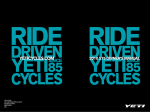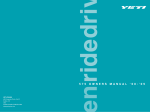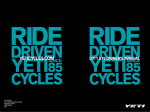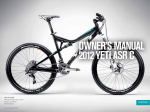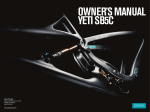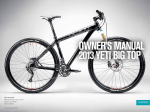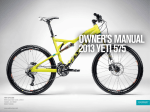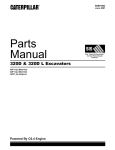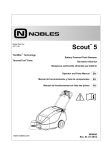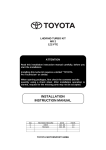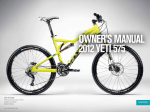Download Yeti Cycles 575 Owner`s manual
Transcript
575 Owner’s manual ’07 Yeti Cycles 600 Corporate Circle, Unit D Golden, CO 80401 USA 303.278.6909 / 888.576.9384 www.yeticycles.com Table of Contents Brand Overview 6 Frame Features 8 Geometry 10 Maintenance Schedule 12 Bike Setup Overview 14 ūū Shock Setup FOX RP23 16 ūū Shock Setup FOX DHX Air 17 ūū Quick Start Guide 19 ūū Cable Routing 20 Assembly Overview 22 ūū Assembly 24 ūū Disassembly Tips 28 Exploded Views 20 Part List 32 Warranty 34 Contact Information 35 Overview Welcome to the tribe Congratulations on your purchase of a new Yeti bicycle and welcome to the Yeti Tribe. We are confident your new bicycle will exceed your expectations for value, performance and ride quality. Each frame set and component has been custom specified and designed to enhance your riding experience. Whether you are a beginner cyclist or a seasoned pro, Yeti bicycles will provide endless hours of two-wheeled fun. General information This model-specific manual is designed to be used in conjunction with the general Yeti Owner’s Manual and the manuals supplied by the suspension manufacturers. If you did not receive the Yeti Owner’s Manual or the manual provided by the suspension manufacturer, download the materials off the Internet, or contact you dealer. Bicycling can be a hazardous activity even under the best of circumstances. Proper maintenance of your bicycle is your responsibility and when done properly helps reduce the risk of injury and damage to your bicycle. This manual outlines basic setup and maintenance recommendations of your new Yeti. Because it is impossible to anticipate every situation or condition that may occur during the assembly, setup and maintenance of your bicycle, Yeti recommends that all service and repairs be performed by an authorized Yeti dealer. This manual contains many “Warnings” and “Cautions” concerning the consequences of failure to maintain or inspect your bicycle. The combination of the safety alert symbol and the word “Warning” indicates a potentially hazardous situation in which, if not avoided, could result in serious injury or death. The combination of the safety alert symbol and the word “Caution” indicates a potentially hazardous situation in which, if not avoided, may result in minor injuries or damage to your bicycle or a component of your bicycle. Be sure to read and understand all “Warnings” and “Cautions”. Warning: Make sure you review and understand the warnings, instructions and content of this manual and accompanying manuals for your bicycle. Warning: Technological advances have made bicycles and bicycle components more complex and the pace of innovation is increasing. It is impossible for this manual or accompanying manuals to provide all the information required to properly repair and maintain your bicycle. In order to help minimize the changes of injury, it is critical for you to have work performed by an authorized Yeti dealer. Overview 6 Frame Features 1 1. Pure tubing Yeti pure tubing is custom butted and tapered 7005 aluminum. This makes the frame lightweight and strong without the use of gussets. Unique shape provides added strength at the head tube junctions. 7 2. Bottom bracket 73mm shell, for use with a 113mm spindle. 3. Seatstay (a) + Chainstay (b) Square seatstays are stiff and strong. Asymmetrical chainstays provide chainring clearance and are light and strong. Accommodates a 2.35’’ tire. 6 4. 3a 4 CarbonFlex pivots allowed us to shave weight and increases performance. I-Beam construction has great lateral stiffness and enhances suspension performance. 5 3b Flex pivots 5. Shock 7.875” eye-to-eye / 2” stroke. 6. Dogbone Dogbone controls suspension rate and enhances rear end stiffness. Sealed cartridge bearings allow the dogbone to move freely. 8 7. Knuckle CNC machined knuckle junction allows for greater stand-over clearance. This is the strongest part of the frame. 2 8. Main pivot Oversized sealed bearings on main pivot for low maintenance and stiction-free performance. Features 8 Geometry B G e o m e t ry 5 7 5 140 mm fork (ride height 511mm) I A D E F G Geometry M L XL S M L XL A 17.5 18.5 20.5 21.5 17.5 18.5 20.5 21.5 B 22.4 23.4 24.4 25.2 23 24 25 25.8 C 68.5 68.5 68.5 68.5 66.9 66.9 66.9 66.9 D 71.5 71.5 71.5 72.5 70.4 70.4 70.4 70.4 E 16.9 16.9 16.9 16.9 16.9 16.9 16.9 16.9 F 41.8 42.8 43.8 44.4 43.5 44.5 45.5 46.4 G 13.75 13.75 13.75 13.75 14 14 14 14 H 29.25 29.25 29.25 29.25 29.7 29.7 29.7 29.7 I 4.5 4.5 5.25 6 4.5 4.5 5.25 6 C H 10 160 mm fork (ride height 545mm) S *All measurements are in inches. Maintenance? Not sure how to work on your own bike? Contact your authorized Yeti dealer or visit www.parktool.com and check out the repair help section. This section contains detailed instruction on many of the service items listed in the maintenance schedule. Maintenance Maintenance Following these guidelines will help maintain the performance of your bicycle and prevent Torque We have attached a brief list of torque specifications for bolts and components that may need to more serious problems from arising. It is important to remember that service intervals can vary depending on climate, trail conditions and riding frequency. be tightened while performing basic maintenance. This is just a guide. For specific torque, specifications, please contact the component manufacturer directly. ACTION WEEKLY Clean and lube chain x Check tire pressure x MONTHLY 3 MONTHS ANNUALLY Pivot Bolts Derailleur Hanger Bolts x Clean bike of mud and debris (never spray water directly into frame or components) Torque Specs 150 -180 Stem Binder Bolt 175 -260 150 -180 175 -250 Check brake function x Check shock pressure, if applicable x Saddle Clamp Bolts Check for loose bolts and tighten, if necessary x x Thoroughly clean pivot points with a rag (do not lubricate) x Replace brake pads, if necessary x Check tires for wear x Check spoke tension and retention, if necessary x Check chain for worn, damaged, or loose links, replace chain if necessary x Maintenance 12 Rear Derailleur 70 -86 Front Derailleur Clamp 45 -60 Chainring Bolts 88 -132 Caution: The torque specifications listed should be used as a guide when performing maintenance. Technological advances have made bicycles and bicycle components more complex, and the pace of innovation is increasing. Because of these advances, Yeti recommends that you refer to the torque specifications of the manufacture’s component you are adjusting. In order to help minimize the chances of injury, do not perform any maintenance that you are not confident can be completed within your abilities. x Complete tune-up performed by an authorized Yeti dealer 30 -45 Handlebar Binder Bolt Seatpost Binder Bolt Check headset and tighten / loosen, if necessary 125 -150 Bike Setup Tools needed Shock pump Tape measure 4mm allen key Time 15-20 minutes Yeti Tips Inspect your shock for any visible damage. If oil is leaking or you notice any damage to the surfaces or seals, please contact the Fox Racing Shox service center for repair at 800.FOX.SHOX. Removing the shock from the linkage will require the Yeti linkage tool for proper assembly and disassembly. The tool can be purchased online at www.yeticycles.com or through an authorized Yeti dealer. SETUP 14 Setup-Fox DHX Air Setup-Fox RP23 Air pressure The main air spring controls the sag of the shock. For the 575 to ride properly it is important to setup the shock with the correct amount of sag. For general riding use 20-30% of the shock stroke (5mm to 10mm). To increase sag reduce the main spring air pressure. To reduce sag increase the main spring air pressure. Refer to the quick start guide to get your starting air pressure. 1 Setup Overview The DHX 5.0 employs both speed sensitive rebound damping and positive sensitive compression damping. There are three external adjustments that affect the compression and one external adjustment for the rebound. The three compression adjustments are bottom-out resistance, boost valve and pro-pedal. The pro-pedal controls the anti-bob properties of the shock or the first part of the shock’s stroke; the bottom-out resistance controls the end of the shock stroke; and the boost valve damping links these two adjustments together to create a seamless transition through the entire stroke. The boost valve also decouples the pro-pedal and bottom-out resistance making these adjustments independent of each other. Air pressure The main air spring controls the sag of the shock. For the 575 to ride properly it is important to setup the shock with the correct amount of sag. For general riding use 20-30% of the shock stroke. To increase sag reduce the main spring air pressure. To reduce sag increase the main spring air pressure. Refer to the quick start guide to get your starting air pressure. 1 2 sag Once you have set your baseline air pressure you need to measure the sag. To measure the sag slide the travel indicator (O-Ring) up against the shock body. With a friend supporting the bike, sit on the saddle (do not bounce) and allow your body weight to compress the shock. Once you have compressed the shock, get off the bike and measure the distance between the shock body and the new position of the travel indicator (O-Ring). This is your sag. Refer to the guide below for the percentage of sag equivalents for the measurement recorded. Firm Ride - 20-25% sag Plush ride - 30% sag Firm ride- 20-25% sag Plush ride- 30% sag Warning: Use of the shock with improper air pressure can cause loss of Pro-Pedal The pro-pedal dampening has three levels of adjustment and is controlled by the blue lever (formerly the lock-out lever). The three different levels of dampening are light, medium and heavy pro-pedal. dampening and malfunction of the shock. 3 We recommend setting the pro-pedal in the middle of its adjustment range (position 2). If you feel like the bike is too firm and is not absorbing the small bumps, flick the lever left to the light setting. If the bike feels sluggish and you want the suspension to feel more efficient, turn the lever right to the stiffer setting. rebound The rebound adjustment has a nine-click range. The rebound knob is the red adjustment dial located above your blue propedal adjustment lever. As a general rule, adjustments that are too fast (counter-clockwise adjustment) will produce a springy ride with excessive kick-up of the rear end causing a bucking sensation. Adjustments that are too slow (clockwise adjustment) will cause packing of the rear wheel indicated by a sluggish ride feeling ride. 4 Slower rebound- turn the knob clockwise Faster rebound- turn the knob counter-clockwise SETUP shock RP23 16 boost valve The DHX 5.0 has an air pressure range of 75-200 psi, and it must be pressurized for the shock to work properly. The Boost Valve allows the Pro-Pedal (beginning compression) and the Bottom-Out Resistance (ending compression) to work seamlessly together. Because of this relationship the Boost Valve pressure affects both the Bottom-Out Resistance and the Pro-Pedal Adjustments (see adjustment relation). 2 Lower pressures (75 – 100 psi)- will decrease bottoming resistance and lessen pro-pedal stiffness at a given setting. Higher pressures (110 – 200 psi)- will increase bottoming resistance and stiffen pro-pedal at a given setting. Warning: Use of the shock with improper air pressure can cause a loss of dampening and shock malfunction could occur. Do not attempt to turn the adjuster with more than 125 psi in the chamber. Setup-Fox DHX Air sag Once you have set your baseline air pressure you need to measure the sag. To measure the sag slide the travel indicator (O-Ring) up against the shock body. With a friend supporting the bike, sit on the saddle (do not bounce) and allow your body weight to compress the shock. Once you have compressed the shock, get off the bike and measure the distance between the shock body and the new position of the travel indicator (O-Ring). This is your sag. Refer to the guide below for the percentage of sag equivalents for the measurement recorded. 3 4 bottom-out resistance The bottom-out adjuster has three full turns of adjustment. This adjustment controls the bottom out resistance of the shock, or the compression on the final part of the shock’s stroke. If you feel like you are bottoming-out the shock on big hits, you can minimize this sensation by increasing the bottom-out resistance. More resistance- clockwise rotation Less resistance- counter-clockwise rotation The adjuster can be turned by hand or with a 4mm allen key. The allen key should be placed into one of the holes on the perimeter of the adjuster. Pro-Pedal The pro-pedal adjustment has a 15 click range of adjustment. The pro-pedal dampening affects the first half of stroke where most rider induced bob occurs. 5 More Damping - clockwise rotation Less Damping - counter-clockwise rotation Quick Start Guide Quick start guide rp23 575 Air Spring Settings Rider Weight lbs 125 135 145 155 165 175 185 195 205 215 Air Pressure (psi) 135 145 155 165 175 185 195 205 215 225 Sag Settings *External Adjustments Sag % 20 25 30 Rebound 4 Clicks Measured (mm) 10 12.5 15 Pro-Pedal Lever ON Pro-Pedal Knob Level 2 Quick start guide dhx air 575 Air Spring Settings Rider Weight lbs 125 135 145 155 165 175 185 195 205 215 Air Pressure (psi) 145 155 165 175 185 195 205 215 225 235 Boost Valve Settings 109 116 124 131 139 146 154 161 169 176 Sag Settings *External Adjustments Sag % 20 25 30 Rebound 10 Clicks Measured (mm) 10 12.5 .15 Bottom-Out Resistance 1.5 Turns Pro-Pedal 5 Clicks *All clicks are clockwise rotation from all the way out or a full counter-clockwise position. Rebound The rebound adjustment has a nine click range. As a general rule, adjustments that are too fast (counter-clockwise) will produce a springy ride with excessive kick-up of the rear end. Adjustments that are too slow (clockwise) will cause packing of the rear wheel and give the bike a sluggish feel. 6 S lower rebound - turn the knob clockwise Faster rebound- turn the knob counter-clockwise SETUP DHX air 18 What is Pro-Pedal? Pro-pedal is a compression tune that gives the right amount of low-speed compression to filter out unwanted rider-induced bob without sacrificing critical midand high-speed damping. No flushing through your travel, no wasted setup time, and no energy-sucking suspension movement. Just super efficient pedaling performance ready for hits of any size. Housing End Caps Yeti recommends using metal end caps to maintain the integrity of the housing. The metal caps do not allow the cable to pull through as do the plastic versions. Do not mix up the shift and brake housing because it will result in a loss in performance. Cable Setup The 575 has full cable housing. By using full cable housing, we have eliminated break points in the line of your shifter housing. This allows riders to experience better overall shifting performance by reducing the entrance of unwanted elements such as sweat and sediment. Use of full cable housing helps prevent corrosion from the elements and keeps the shifting smoother for a longer period of time. Caution: The failure to properly route shifter housing can cause malfunction of the shift mechanism and unexpected shifting of gears. rear derailleur Fit the housing from the rear shifter across the head tube and down the cable drop outs. There are three cable drop outs groups on the non-drive side of the down tube to which the housing and brake line can be attached. Fit the rear housing along the down tube into the drop outs that are for the rear brakes. 1 The routing of the housing around the bottom bracket is a little tricky. The shifter housing is looped over the bottom bracket shell and then passed over to the drive side chainstay. The final stretch of rear derailleur housing is attached using c-clips on the drive side chainstay and looped into the derailleur. front derailleur Fit a piece of housing form the front shifter across the head tube into the first cable stop on the drive side of the top tube. 2 The cable runs parallel along the drive side of the down tube and then slides into the cable guide under the bottom bracket shell. Sometimes the plastic guide from the front derailleur is oriented incorrectly. The cable should run thru the long guide. This should be positioned on the drive side of the bike closest to the crank. Make sure cable does not make contact with frame. rear brake The rear brake loops across the head tube and into the cable drop outs on the non-drive side of the down tube. Use the plastic c-clips to secure brake line to your frame. Then the attached line is to the open stops on the top of the non-drive chainstay. Make sure the line is on the inside of the seatstay when attaching the caliper body. 3 Note: This will prevent the brake line from being compromised if the bike or rider falls. SETUP HOUSING 20 Assembly Tools needed Dead blow hammer Adjustable pliers Two - 5mm allen keys 6mm allen key 4mm allen key 4mm t-handle allen key 8mm allen key or 5/16 guide Linkage tool Time 30-45 minutes depending on condition of the bike Yeti Tips Make sure your tools are in good condition. A worn allen key can round the hex on a bolt preventing proper torque. Be careful when using ballpoint allen wrenches for the same reason. The linkage tool is necessary to properly disassemble and reassemble the linkage. Using a hammer to tap out the pin can cause damage to the linkage and shock. Torque settings are listed throughout the instructions. It is also important to prep all bolt threads. The instructions denote whether to use a blue Loctite compound or grease. Not every tool may be needed for the assembly / disassembly of your bike. The list encompasses all the tools necessary to completely assemble and disassemble each bike. Warning: Service on Yeti bicycles requires special knowledge and tools. Yeti Cycles recommends that all service and repairs be performed by an authorized Yeti dealer. assembly 22 Thread Prep Yeti recommends prepping all bolt threads at once on your work bench with Loctite or grease. This will ensure that all bolts are used in assembly. The medium strength (blue) Loctite formula along with proper torque is ideal to keep the bolts snug. Assembly 1 linkage assembly Slide a washer, press-cup and press-cup insert onto the threaded bolt of you linkage tool. Linkage Assembly Place the dogbone over the shock with the counter-bored holes facing out, what would be back towards the seat tube, and the threaded end facing towards the shock. Slide the pin subassembly into the shock eyelet as shown. 5 Tip: You will need to press evenly using your body weight in order for the steel pin to slide through the garlock bushing in the shock eyelet. Linkage assembly Place two of the dogbone bearings (300020029) and the 1.38’’ steel pin onto the threaded bolt as shown. Now put on the linkage tool washer and nut (200020071). At this point tighten down the assembly with two 1/2 inch wrenches. 2 Linkage Assembly Once you have the pin subassembly started into the shock eyelet, you can slide the threaded bolt, press-cup and press-cup insert configuration from step one through the steel pin subassembly and shock. On the opposite end of the bolt, slide a second nylon washer, the remaining two bearings, press-cup insert, press-cup, washer and nut. 6 nylon washers 3 Linkage assembly The procedure in step two produces a relief, shown on the right, that aids in the assembly. Linkage assembly Slide one of the black nylon washers (300030100) onto the steel pin flush against the inside edge of the bearings. 4 Linkage assembly Use two 1/2’’ wrenches and torque the linkage together until the bearings press into position. Make sure bearings are flush on both sides of dogbone. This will ensure proper alignment of the swing arm once it is installed. 7 Linkage assembly Insert the small socket head cap screws (300030056) into the dogbone and torque down with a 2.5mm allen key. Make sure to prep the bolts with Loctite. 8 Torque spec: 125-150 inch/pounds. assembly 24 Assembly Cont. Frame Assembly Place the shock assembly onto the bike in the configuration shown to the right. Slide your first 33mm female bolt and washer through mounting position one to hold the shock assembly in place. Now swing the dogbone into mounting position two. Slide the other 22mm female Yeti bolt and washer through the mounting hole of the bike. Tap the 22mm female Yeti bolt into position with the dead blow hammer. 9 Note: All female bolts and the main pivot are installed from the drive side of the bike. 10 frame assembly Thread the male Yeti bolts into the 22mm female bolts and tighten down with 5mm allen keys. Note: The shoulder on the bolt should not be visible. The bolt should fit flush against the frame. Be careful when tightening, make sure the shoulder of the male bolts do not bind or bend the washers. . frame assembly First slide the swing arm over the main pivot as shown, notice the recess cut in the swing arm in front of the bearings. The recess should be lined up over the main pivot lip to ease the installation process. Slide the seatstays over the steel pivot pin. Now slide the 41.2mm female Yeti bolt and washer through the seatstays and shock assembly. Place a male Yeti bolt with a washer on the non-drive side of the bike. Tighten down both Yeti bolts with 5mm allen keys. 11 Note: Assemble this first so the seatstays don’t hit the frame when hammering in the main pivot pin. Frame Assembly Make sure the bearings are lined up with the main pivot before tapping the lightly greased main pivot pin through the frame with the dead blow hammer. 12 Tip: Use your left index finer to align the main pivot while installing. assembly 26 Frame Assembly Install the black washer and button head bolt over the main pivot pin as shown. Cinch the button head down with a 5mm allen key while holding the main pivot with 6mm allen key. 13 The last step is to install the derailleur hanger and water bottle bolts. Disassembly Tips frame disassembly To remove the main pivot pin, place a 5mm allen key on the button head bolt and a 6mm allen key on the main pivot pin. Turn counter-clockwise until the button head is removed. Then take 8mm allen key or a punch and tap out the main pivot pin with a dead blow hamemr. 1 Note: Disassemble this first so that the seatstays don’t hit the frame when hammernig out the main pivot pin. frame disassembly Now remove the male and female Yeti bolts that attach the seatstays to the shock and dogbone. You will need two 5mm allen keys in order to back off these bolts. Your swing arm should now be free to slide off the front triangle. 2 frame disassembly To remove the shock mounting bolts, place a 5mm allen key on both ends of the bolts and turn counter-clockwise. Once the male Yeti bolt is removed, take a 6mm allen key and tap out the female end. 3 Note: This methods works for all three mounting bolts on a Fox Racing Shock. 4 frame disassembly Use a 2.5mm allen key to loosen the socket head cap screws from the dogbone. disassembly 28 frame disassembly Slide a washer and removal slug onto the threaded bolt. Slide this subassembly through the shock and dogbone. On the opposite end, slide on the catch sleeve, washer and then thread the nut on. 5 Use two 1/2’’ and adjustable wrenches and torque down until the removal slug presses the steel pin out of the dogbone bearing assembly. Rebuild Kits The individual components of each Yeti bike are not sold separately. All Yeti parts are sold in rebuild kits listed below. Each and every part can be obtained by purchasing one of the rebuild kits. Cross reference the part number you desire from the parts lists. Exploded Views Parts list w/fox shock Qty. exploded views 30 Part # Description 1 1 NA Front Triangle 2 1 NA Swingarm 3 1 NA Rear Shocl 4 2 300020020 Fox Garlock 5 2 300020034 Reducer- 22mm (front) 6 1 300040210 2007 575 Dogbone 7 1 300030085 Pivot Pin (M6 x 17 x 52.4mm) 8 1 300030087 Pin- Steel Shock- 1.38 ASR 2 9 1 300030015 Bolt- Pivot (8 x 41.2mm) 10 2 300030077 Yeti Pivot Bolt Female (M6 x 1 x 24.8mm) 11 3 300030078 Yeti Pivot Bolt Male 17mm 12 1 300030006 Bolt Button HD (M6 x 1 x 12mm) 13 1 300030045 Main Pivot Washer 14 6 300030069 Washer (8.5 x 12.5 x 0.5mm) 15 2 300030100 Washer Blk Nyl 0.7 x 0.51 x 0.061 16 2 300020001 Bearing 6903 Max 17 4 300020029 Bearing 0.75 x 0.5 18 2 300020026 Bearing 16 x 8 x 5mm w/ Ext Race 19 2 300020027 Bearing 16 x 8 x 5mm 20 1 300060045 Derailleur Hanger w/ Fasteners 21 2 300030056 Bolt Cap (M3 x 0.5 x 12) N/A 4 300030010 Bolt-Cap H20 (M5 x 0.8 x 16mm) Parts List PART NUMBER 200020066 200020073 DESCRIPTION Qty. BOLT-BUTTON HD M6X1X12 5mm hex 1 bearing 16mmx8mmx5mm 2 300030087 PIN - STEEL SHOCK - 1.38 ASR 2 1 bearing 16mmx8mmx5mm W/ext ring 2 300030100 WASHER- BLK NYL .70X.51X.061 4 300020029 BEARING .75X.5 4 300040210 DOGBONE- 575 1 300030107 bolt g5 5/16-24x6.5 4 300030056 BOLT CAP M3X0.5X12 2 300030126 machine parts for tool 1 300030100 WASHER- BLK NYL .70X.51X.061 2 300030105 finished hex nut 5/16-24 1 300030087 pin- steel shock- 1.38 ASR 2 1 PIN - STEEL SHOCK - 1.38 ASR 2 1 300030078 PIVOT bolt MALE YETI 17MM 1 300030015 Pivot Bolt - 8x41.2mm 1 300030069 WASHER SS 8.5MM ID 12.5MM OD 2 300030100 WASHER- Blk NYL .70X.51X .061 2 1 575 ‘04-07 BEARING REBUILD KIT WASHER-BLK NYL.70X.51X.061 2 300020027 bearing 16MMX8MMX5MM 2 300020026 bearing 16MMX8MMX5MM w/ext ring 2 300020029 BEARING .75 X .5 4 300020001 BEARING 6903 MAX 2 300030006 BOLT-BUTTON HEAD M6X1X12 5mm hex 1 300030092 HAT-O-RING-PIN - PROG AIR SHOCK 2 300030090 PIN - PROGRESSIVE AIR SHOCK 1 300030094 O-RING - PROGRESSIVE AIR SHOCK 2 300030100 WASHER- blk NYL .70X.51X.061 2 1 575 ‘04-07 MASTER REBUILD KIT (W/FOX MOUNTING HARDWARE) bearing 16MMX8MMX5MM 2 300020026 bearing 16MMX8MMX5MM w/ext ring 2 300020029 BEARING .75 X .5 4 2 300020001 BEARING 6903 MAX 300030015 bolt- Pivot Bolt- 8x41.2mm 1 300030077 PIVOT bolt FEMALE YETI 24.8MM 2 300030078 PIVOT bolt MALE YETI 17MM 3 300030069 WASHER SS 8.5MM ID 12.5MM OD 6 300030179 WASHER- custom PIVOT pin- 7075 1 300030085 PIVOT PIN- AL- 17mmx52.4mm 1 32 200020071 1 575 ‘04-07 FOX MOUNTING HARDWARE 300020027 parts List DESCRIPTION 300030006 300020027 300030100 200020063 PART NUMBER 1 300020026 300030087 200020065 Qty. 575 ‘04-07 DOGBONE PLUS BEARINGS linkage tool 1 Warranty Yeti Limited (2) Two Year Frame Warranty (applies to 303, 4X, DJ) Disclaimer Yeti Cycles will repair or replace, at its option, any frame it determines to be defective materials and / or workmanship. The (2) two year limited warranty is conditioned upon the bicycle being ridden under normal conditions and having been properly maintained. This warranty does not apply to the components attached to the frameset such as suspension components, wheels, drive train, brakes, seatpost, handlebar and stem. This warranty applies only to the original owner and is non-transferable. This warranty is void if the bicycle was not properly assembled by an authorized Yeti dealer. Yeti Cycles is not responsible for any damages to you or others arising from riding, transporting or other use of your bicycle. In the event that your frame breaks or malfunctions, Yeti Cycles shall have no liability or obligation beyond the repair or replacement of your frame pursuant to the terms outline in this warranty. Yeti Limited (5) Five Year Frame Warranty (applies to AS-R sl, AS-R Carbon, 575, ARC, ARC-X) Yeti Cycles will repair or replace, at its option, any frame it determines to be defective materials and / or workmanship. The (5) five year limited warranty is conditioned upon the bicycle being ridden under normal conditions and having been properly maintained. This warranty does not apply to the components attached to the frameset such as suspension components, wheels, drive train, brakes, seatpost, handlebar and stem. This warranty applies only to the original owner and is non-transferable. This warranty is void if the bicycle was not properly assembled by an authorized Yeti dealer. Additional Conditions These limited warranties do not apply to normal wear and tear, nor to claimed defects, malfunction or failures that result from abuse, neglect, improper assembly, improper maintenance, alteration, collision, crash or misuse. The original owner shall pay all labor charges connected with the repair or removal of all components. Under no circumstances does this limited warranty include of the cost of travel or shipment to and from an authorized Yeti dealer. In order to exercise your rights under these limited warranties, the bicycle or frameset must be presented to an authorized Yeti dealer, together with proof of purchase. ūū The above warranties have been in effect since January 2000. All Yeti frames sold prior to that date had a limited (1) one year warranty on the frameset. ūū No Fault Replacement Policy ūū Yeti Cycles will make replacement parts available at a minimum charge to the original owner in the event of a crash or any other non-warranty situation. Yeti Cycles does this at its sole discretion and reserves the right to refuse this offer. ūū If you have a warranty concern, please contact your authorized Yeti dealer. No Fault Replacement Policy Yeti Cycles will make replacement parts available at a minimum charge to the original owner in the event of a crash or any other non-warranty situation. Yeti Cycles does this at its sole discretion and reserve the right to refuse this offer. If you have a warranty concern, please contact you authorized Yeti dealer. Product Life Cycle Every Yeti frameset has a useful product life cycle. The length of that useful product life cycle will vary depending on the construction and materials of the frameset, maintenance and care the frameset receives, and the amount and type of use the frameset is subjected to over its life. Yeti recommends that an authorized Yeti dealer should inspect the frame for stress annually. Frame stress could cause potential failure and the signs are usually apparent in the form of cracks, fracture lines, deformation, dents and other visual indicators of abnormality. These safety checks for frame stress are important to prevent accidents, injury to the cyclist and product failure of a Yeti frameset. Warranty 34 Contact info Yeti Cycles 600 Corporate Circle, Unit D Golden, CO 80401 (p) 303-278-6909 (f) 303-278-6906 www.yeticycles.com BUSINESS HOURS Monday-Friday 8AM-11:30AM, 1:00PM-5:30PM (Mountain Time)

















